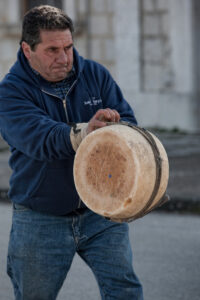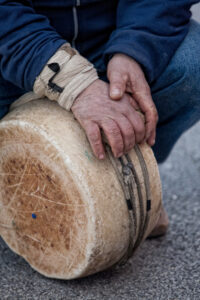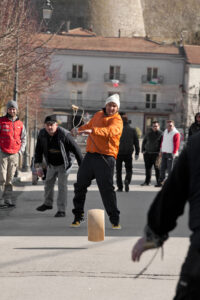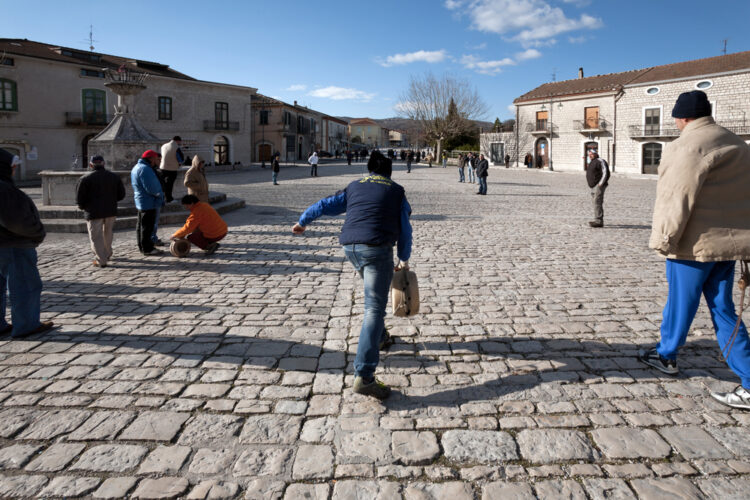He’s seriously psyched up as he wraps a long stretch of fibrous cord around a 30cm ball of hard cheese. The smoke from the cigar, wedged into the corner of his mouth, necessitated that he close one eye. His other eye accessed the camber of the road ahead. He took a couple of long strides to build up momentum, leaned his ample frame forward, and, with a curved slingshot motion (delivered in an elegant pirouette), launched his wheel of cheese.
He leaned this way, then that way, grimace – baring his teeth, closed his good eye, then quickly opened it again. In the distance his cheese skittered along the surface of the black asphalt, telepathically following its curve. It rounded a bend, then settled on a grassy verge on the roadside.

I’m walking behind a group of farmers heading up a rural mountain road in Castel Di Lama (in the Marche region of Italy). Each man is carrying a scruffy-looking shoulder bag – and their cheese.
“They’re out practicing for the ‘Ruzzola’ national championships,” I’m told. “It’s a Pecorino cheese-rolling race.”
The purpose of Ruzzola is to projectile toss balls of cheese towards the goal, which was somewhere in Offida, a neighbouring village.
The origins of the Ruzzola date back to medieval times. Most players were farmers and shepherds who would throw seasoned pecorino cheese along sloped grassy paths. Today, it is recognized by the Italian Sport Federation, which organizes numerous tournaments and events every year throughout the country.
The rules are simple – wrap coarse string around the girth of the cheese, then launch it by unwinding the string, with one end held in one hand. The method used is best described as playing yo-yo and ‘walking the dog’, then letting go to see how far it travels – that’s near enough to what Ruzzola is.

The aim is to reach a fixed point with the least possible number of launches. The winner is the one who managed to launch it the farthest.
Visiting a local sheep farm, I learned about Pecorino cheese, which is hard and salty, and made of raw sheep’s milk.
Originally it was a staple in the diet for the legionaries of ancient Rome. Today, it is still made according to the original recipe and is one of Italy’s oldest cheeses.
The maturation process is an interesting one as the dry-salted cheese wheels are placed on wooden boards for a couple of days, giving it time to dry and form an outer skin. Then, they’re greased with olive oil that’s been flavored with local herbs. I’m told that adding herbs has a sanitizing action, eliminating bacterial flora in milk, which adds powerful aromatic aromas.
They’re left to mature in a cold room for about twenty days – and up to a year for the aged variety. The shortly-aged version is softer and lighter, while the matured version is hard, greasy to the touch, and much darker in color.
The region of Marche has its own take on maturing their Pecorino. Here, the cheese is aged for up to sixty days. Then, as was the custom of shepherds since the Roman times, the cheese wheels are wrapped in walnut leaves, placed into well-sealed oak barrels in which wine was once stored, and aged still further for around ninety days. This gives it time tore-ferment, acquiring its characteristic taste and aroma.
Once removed from the wine barrels, the cheese is left to dry for about ten days, packaged in jute paper, and sold after a month. The result is a hard, mouth-watering, fat cheese with herbal aromas and a crumbly texture.
Fresh pecorino is considered table cheese and is served on its own or as an appetizer with cold cuts. When aged, it is used grated or flaked as an ingredient to enrich the taste of many traditional Italian dishes such as Cacio e Pepe, which the locals have down to a fine art.
Chef Daniele Citeroni at Michelin-starred Ophis in Offida gave me a few tips: cook spaghetti in just enough water to cover it and, using tongs (no draining or letting it drip dry), transfer the pasta to a second skillet containing a sauce made up of just two ingredients – coarsely ground black pepper, toasted in olive oil. Once the pasta has been stirred around and is coated with the pepper-infused olive oil, add the aged, finely grated (near powdered) Pecorino. Swirl it around a little, add a little more olive oil, salt, and pepper to taste, and top it off with a fistful of Pecorino.
“And the winning team,” I asked Maria. “What’s in it for them?”
 “It’s the honor, I suppose, and the trophy,” said Maria Vallorani, the chairperson of the local team. She contemplated her statement, then added, “But this is Italy; there is a festival for everything, and no doubt someone will be offering Maccheroncini di Campofilone pasta – a 600-year-old pasta particular to the region. It’s fine, thin strands – often referred to as angel hair pasta – are made with a lot of eggs, durum wheat, and semolina flour and melt in the mouth deliciously. This comes with gratings of the winner’s cheese on top.”
“It’s the honor, I suppose, and the trophy,” said Maria Vallorani, the chairperson of the local team. She contemplated her statement, then added, “But this is Italy; there is a festival for everything, and no doubt someone will be offering Maccheroncini di Campofilone pasta – a 600-year-old pasta particular to the region. It’s fine, thin strands – often referred to as angel hair pasta – are made with a lot of eggs, durum wheat, and semolina flour and melt in the mouth deliciously. This comes with gratings of the winner’s cheese on top.”
I had visions of the 5km journey the cheese wheel would cover – and at the end of its travels, all the debris that may well be embedded into its hard crust. Bits of squashed porcupine, chewing gum, cigarette butts, tire rubber, larks’ vomit…
Maria reads my facial expression and gives me a slow wink adding: “I’m sure they’ll wipe the cheese off with a kitchen towel first.”


